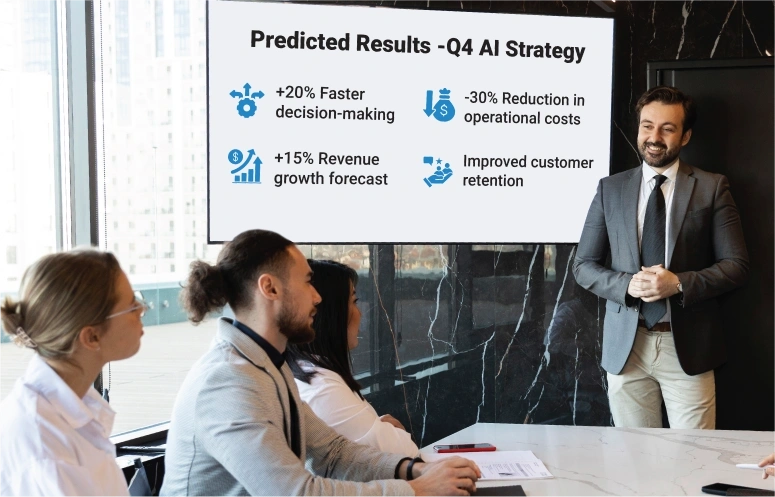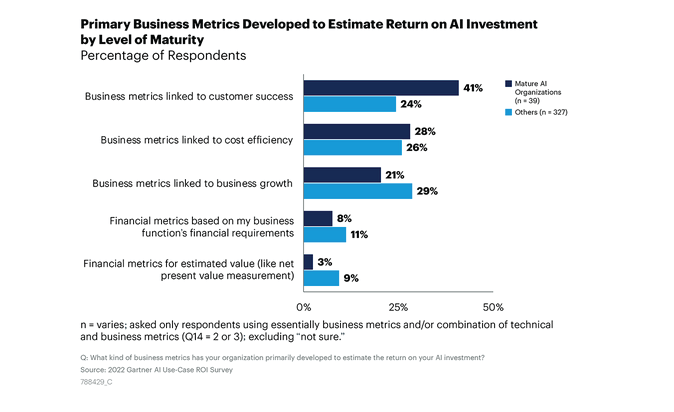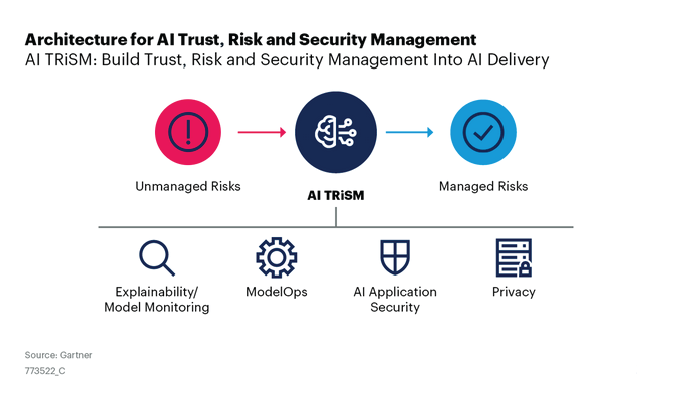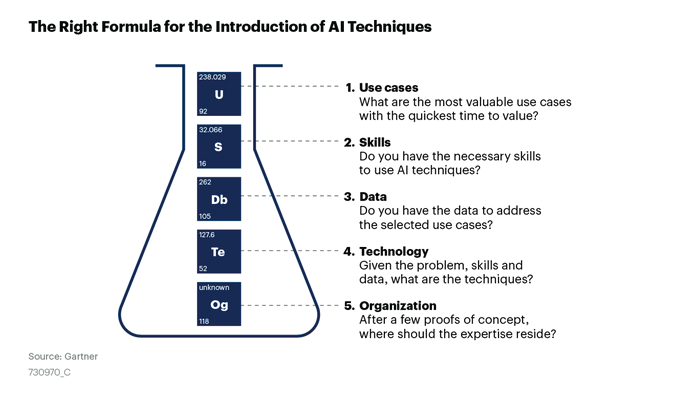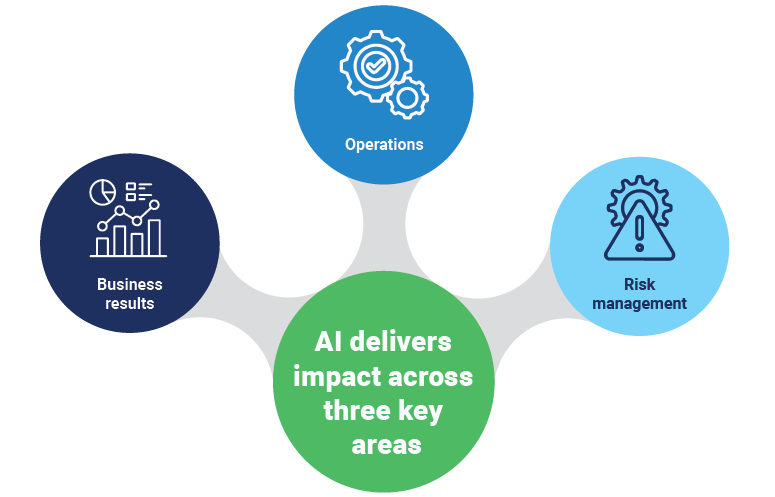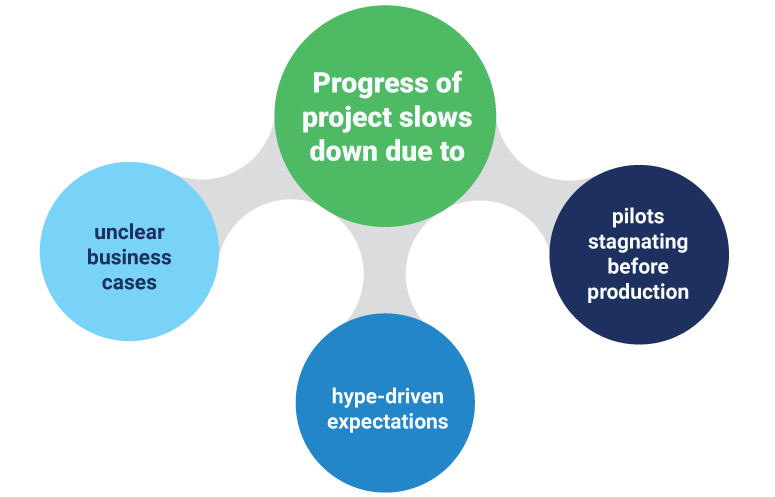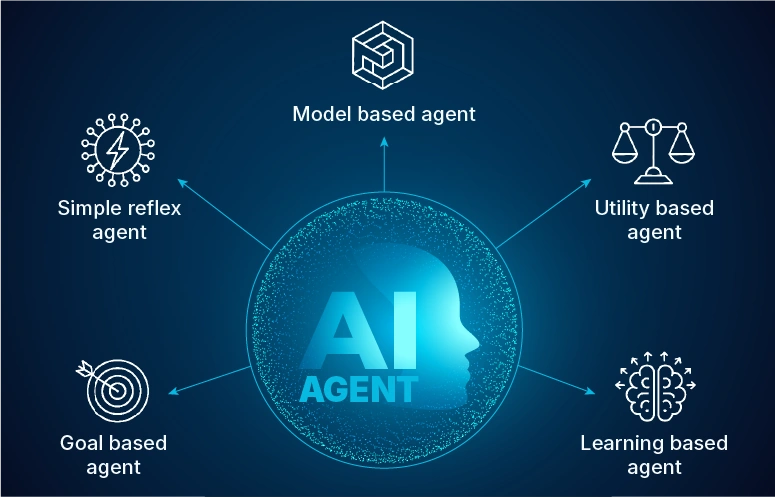AI promises growth, yet many programs struggle to turn goals into results. In manufacturing, AI matters because customers expect shorter lead times and higher quality, plants need automation to unlock capacity, and regulators require stronger traceability. Among AI capabilities, computer vision is production-ready today for inspection, safety, and throughput. The opportunity is real, but when budgets are limited, value must be demonstrated on the line first.
Organizations can invest in a top-tier platform, but workforce adoption depends on enablement, workflow fit, and trust. In a 2024 Gartner survey, 87% of employees needed ongoing training and 60% had not used GenAI for critical work; top adoption blockers included limited GenAI training (30%) and poor-quality GenAI responses (29%).
This post covers why AI matters for enterprise growth in 2025, the real adoption challenges, a clear build-or-buy path, and four strategies to deliver measurable results.
What is an AI strategy?
An AI strategy is the cornerstone of effectively integrating AI into a business. It acts as a roadmap, guiding you on how to leverage AI to achieve specific business goals. Whether it’s extracting deeper insights from data, enhancing operational efficiency, or building better customer experiences, your AI strategy defines the how and why of achieving success with AI.
This plan also encompasses crucial considerations such as:
- Tech infrastructure: Ensuring companies have the hardware, software, and resources needed for AI implementation.
- Adaptability: Remaining flexible to embrace evolving technologies and industry shifts.
- Ethical responsibility: Addressing concerns like bias, transparency, and regulations for responsible AI use.
AI strategy pillars
1) AI vision
Forget about simple automation tasks. Artificial intelligence, particularly generative AI, holds the key to revealing game-changing possibilities for any organization. Imagine crafting personalized marketing content that resonates with each individual customer, tailoring product designs based on real-time preferences, or even conceptualizing entirely new product lines fueled by AI-driven insights. These are just a few glimpses into the transformative potential of AI.
Industry leaders are taking the leap
Across various industries, companies are leveraging generative AI to achieve remarkable results. In the retail sector, AI generates personalized product recommendations that boost sales and customer satisfaction. In healthcare, AI-powered tools are assisting drug discovery and development, accelerating the fight against diseases. These are just a few examples of how AI is reshaping industries, and yours could be next.
Aligning vision with business goals
Remember, a compelling AI vision shouldn’t exist in a vacuum. It should be firmly anchored in the company’s overall strategic objectives. Ask: How can AI help achieve long-term growth goals? How can it address specific pain points or unlock new opportunities in the market? By aligning the AI vision with the business goals, CIOs can ensure that AI initiatives deliver tangible value and contribute to the company’s success.
Measuring success: Tracking the impact of the vision
Having a clear vision is crucial, but how does one know if they’re making progress? That’s where quantifiable metrics come in. Define clear, measurable goals that directly tie back to the AI vision.
Remember: Visionary AI transcends automation. It fuels innovation, discovers new possibilities, and propels the organization toward a transformed future. Align vision with goals, prioritize impactful use cases, and watch AI become a strategic asset.
2) AI value
While the technology itself is vital, successful AI adoption extends far beyond simply implementing algorithms. It necessitates cultural and organizational shifts to fully maximize its value. Anticipate and address potential resistance by ensuring employees understand the benefits of AI and equipping them with the necessary skills to collaborate effectively with these intelligent tools. Upskilling and reskilling initiatives are crucial, empowering the workforce to leverage the power of AI rather than fearing its disruption.
Generative disruption: Reshaping workflows and skillsets
Generative AI, in particular, has the potential to significantly disrupt existing workflows and skillsets. Proactively address these changes by identifying areas where AI can automate routine tasks, freeing up skilled professionals to focus on higher-value strategic activities. Remember, AI is not a replacement for human ingenuity; it’s a powerful tool that can augment human capabilities and drive exponential growth.
Building a strong foundation: Ethical and responsible AI
Embracing AI innovation shouldn’t come at the cost of ethical or technical compromises. As with any powerful technology, it’s crucial to identify and mitigate the potential risks associated with AI, especially when dealing with generative AI. Understand the unique ethical challenges posed by generative AI, such as potential biases in its outputs or the misuse of generated content. Implement robust governance frameworks that ensure transparency, fairness, and accountability in AI initiatives. Additionally, be mindful of technical risks, such as data security and model explainability. Establishing clear guidelines and processes for responsible AI development and deployment is vital.
Remember: Transparency and trust are key. By proactively addressing potential risks and fostering a culture of ethical AI, CIOs can ensure responsible adoption that benefits their organization and society as a whole.
3) AI risks
Embracing AI’s transformative potential necessitates acknowledging and mitigating its associated risks. This is especially crucial for generative AI, which presents unique ethical and technical challenges.
Understanding generative AI risks
- Bias in outputs: Identify the potential for bias in generative AI outputs, stemming from training data or algorithms. Implement fairness checks and mitigate bias throughout the development and deployment process.
- Misuse of generated content: Anticipate the potential for misuse of generated content, such as deepfakes or biased marketing materials. Establish clear ethical guidelines and user agreements to prevent misuse.
- Operational challenges: Ensure reliable, responsible, and efficient use of LLMs through LLMOps practices. This includes robust governance, version control, monitoring, and security measures to mitigate risks and maximize the benefits of your generative AI systems.
Mitigating the broader AI risks
- Data security and privacy: Ensure robust data security measures to protect sensitive information used in AI training and operation. Be transparent about data collection and usage practices, complying with relevant privacy regulations.
- Model explainability: Understand how AI models reach their conclusions to ensure transparency and build trust. Implement explainability techniques and communicate them effectively to stakeholders.
- Job displacement: Address concerns about job displacement due to AI automation. Focus on reskilling and upskilling initiatives to prepare your workforce for the changing landscape.
Building a risk management framework - Establish clear governance structures: Define roles and responsibilities for overseeing AI development, deployment, and risk management.
- Conduct regular risk assessments: Proactively identify and assess potential risks throughout the AI lifecycle.
- Implement mitigation strategies: Develop and implement appropriate mitigation strategies to address identified risks.
- Promote a culture of ethical AI: Foster a culture of transparency, accountability, and responsible AI practices within your organization.
Remember: Responsible AI development is an ongoing process, not a one-time action. By acknowledging and proactively managing risks, CIOs can use AI while ensuring its ethical and responsible use.
4) AI adoption
In the midst of the AI hype, it’s crucial to prioritize use cases based on two key criteria: their impact on your business goals and their feasibility given your data and resources. Don’t get swept away by the latest trends; focus on projects that deliver tangible results and are achievable within your current capabilities.
Impactful and feasible: Balancing ambition with reality
Even the most promising use case might not be feasible if your data infrastructure is inadequate, or your team lacks the necessary expertise. Conduct thorough feasibility assessments, considering factors like:
- Data availability and quality: Does the necessary data exist in sufficient quantity and quality to train and operate the AI model effectively?
- Technology and resources: Does the organization have the necessary tools and infrastructure to support the chosen AI solution?
- Team expertise and skills: Does the team possess the necessary skills and knowledge to develop, deploy, and maintain the AI solution?
By carefully assessing these factors, you can ensure that your chosen use cases are not only impactful but also achievable within your current constraints.
Starting small and scaling up
Remember, AI adoption is a journey, not a destination. Start with small, achievable projects that demonstrate the value of AI and build momentum for further adoption. Generative AI development services can help you identify low-hanging fruit and implement pilot projects to showcase the potential of this technology within your organization.
Examples of prioritized use cases
- Personalization: Leverage AI to personalize marketing campaigns, product recommendations, or customer service interactions for improved engagement and conversion rates.
- Process automation: Automate repetitive tasks with AI to improve efficiency, reduce costs, and free up human resources for higher-value activities.
- Predictive maintenance: Use AI to predict equipment failures and proactively address them, minimizing downtime and maintenance costs.
Delivering measurable AI value while addressing barriers
-
Where AI creates value
Value shows up in three areas: business results (conversion, retention, revenue per customer), operations (lower unit cost, shorter cycle time, higher throughput), and risk (fewer incidents, better traceability). First decide which outcomes you want to achieve; then begin in a workflow where impact is measurable and repeatable, and expand from there. Achieving these outcomes depends on clear success measures, sound unit economics, and results your users can trust.
-
Why progress may slow down
Project progress may slow down when the business case is unclear, expectations are set by hype, and pilots never progress to production. Project costs increase when every use adds model charges plus governance and support effort, and there are no firm thresholds for accuracy, safety, or latency. Data gaps also undermine reliability. In generative AI use cases, unstructured prompts lead to weak document retrieval and poor answers. This results in more retries which increases token use and, over time, discourages continued use.
-
Address the blockers
Define a specific problem and success metric before you start, and conduct a review to decide whether the pilot moves to production. Improve data readiness by fixing quality and integration where the chosen workflow depends on it. Build AI literacy: explain why adoption is helpful, teach by role on real tasks, give practice with feedback, and assess adoption to refine and expand. Focus on a few high-priority opportunities that run through core processes. Keep people and process at the center so technology changes translate into everyday use.
-
Invest in measured steps
Plan around outcomes and advance one workflow at a time with acceptance thresholds. Match spending to maturity, treat inference as an ongoing operating expense, measure cost per outcome, and scale when metrics and user trust are steady.
Growth outcomes to guide your roadmap
Set outcomes first, and let them shape scope, sequencing, and proof. Use three lenses that reflect where enterprises see sustainable gains: revenue, efficiency, and risk. With outcomes defined, a reliable strategy will help you turn plans into production.
-
Revenue impact
Make your offerings more relevant to target customers and use disciplined pricing to convert qualified opportunities and keep customers longer. Confirm the effect by tracking conversion rate, revenue per customer, and customer lifetime value to verify sustained gains.
-
Efficiency gains
Streamline workflows, balance capacity, and improve planning across functions to achieve more with the same resources. Validate the improvement by monitoring unit cost, throughput, cycle time, and forecast accuracy so productivity becomes available capacity.
-
Risk reduction
Strengthen controls to detect issues early, enforce policies, and raise quality before problems reach customers. Demonstrate the shift by measuring incident frequency, time to detect and resolve, and audit exceptions closed to establish a stronger risk posture.
Four strategies to turn AI initiatives into growth
If you’re looking to personalize customer engagement, the real question isn’t if you need a unified view, but how quickly you can act on it. Salesforce CDP brings that capability closer but knowing what to expect helps you align your strategy with customer behavior.
-
Define value before investing
Start small and specific: choose one workflow, name one accountable owner, and write one clear success statement. This keeps scope focused and makes progress visible. Set acceptance thresholds for quality, accuracy, safety, and latency, and move forward when those thresholds are met. Measure cost per outcome rather than cost per prompt, link results to business KPIs, and treat per-request cost as an input to optimize, not the goal. Prioritize core processes first and use a simple checkpoint to decide when a pilot is ready for production.
-
Build AI literacy that drives real use
Start with a clear value proposition so your workforce sees how AI improves their work. From there, tailor learning to roles and practice on real tasks; as teams get hands-on, add feedback that builds evaluation habits and stronger prompting, which also reduces excess token use and improves quality. Finally, track adoption and outcome gains, use the data to adjust the program, and expand what works. Organizations with stronger learning cultures are 2.7X more likely to outperform peers, so literacy is a capability you renew, not a one-time class.
-
Plan for an inference-first infrastructure
Operational use drives cost; every inference run, whether a vision inspection or a co-pilot query, consumes compute and time, and those running costs add up to your cost per outcome. Plan capacity with explicit price-to-performance targets; in parallel, keep deployments portable across clouds and on-prem so placement can follow cost and policy. To control ongoing operating costs, add caching and offline evaluation before release and between model changes; this preserves quality while lowering spend. Set clear Service-Level Objectives (SLOs) latency and availability. Budget with inference as a recurring operating expense so reliability and spend stay aligned as usage grows.
-
Deciding to build vs buy
Deciding between buying a managed, permission-aware LLM platform or building an in-house solution is a strategic choice that affects speed, control, and total cost.
Dimension Buy (managed platform) Build (in-house stack) Team Small platform team 8–10+ platform engineers Scope 1–3 priority use cases Many systems and domains Time to value Need results quickly Can invest time to build Data/hosting Standard cloud is fine Data residency or hybrid required Governance Compliance and audits ready-made Custom evaluations and guardrails Pricing Prefer predictable pricing Optimize via multi-model routing Access and security Mature access controls out of the box Deep workflow and policy integration Customization Limited customization needed High customization by design Portability Vendor portability terms acceptable Portability engineered by design Roadmap and control Vendor roadmap acceptable Avoid lock-in and tune cost over time
Start with one measurable win
The four strategies here give you a practical path. Choose one growth outcome and one workflow that matters now. Put one person in charge, define acceptance thresholds for quality, accuracy, safety, and latency, and set a target for cost per outcome so success is clear.
Baseline current performance, launch in a limited scope, and review results with your finance and security teams. When metrics meet your thresholds, expand; when they don’t, refine the scope, model choices, or training and try again. This simple cycle turns plans into results and builds momentum to help you scale.
